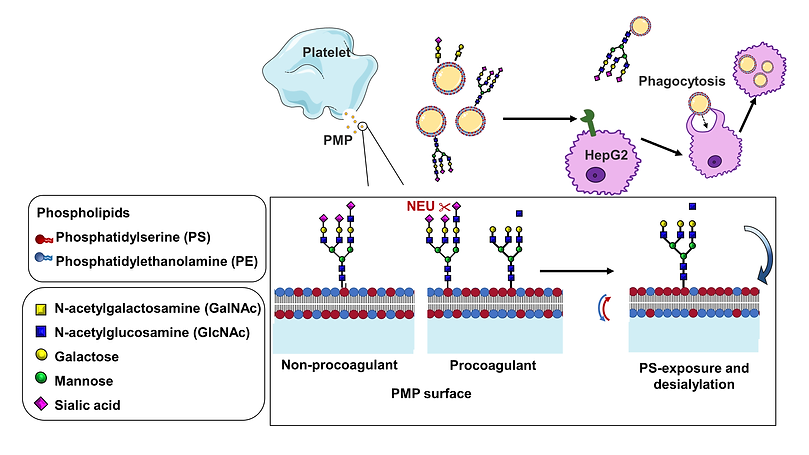LATEST PAPERS
CHANGES IN GLYCANS ON PLATELET MICROPARTICLES RELEASED DURING STORAGE OF APHERESIS PLATELETS ARE ASSOCIATED WITH PHOSPHATIDYLSERINE EXTERNALIZATION AND PHAGOCYTOSIS
April 27, 2022
Platelets release small vesicles (microparticles) during storage. These are important for clotting but also have sugars on their surface which are removed during platelet storage, which are linked to their procoagulant function and clearance from the circulation when transfused. Read here.


DONOR CITRATE REACTIONS INFLUENCE THE PHENOTYPE OF APHERESIS PLATELETS FOLLOWING STORAGE.
Oct, 2021
Accepted in Transfusion! During platelet donation, a small proportion of donors experience adverse reactions, such as citrate reactions: numbness and tingling in the mouth and fingers, with muscle contraction in more severe cases. Apheresis platelets donated by donors that experienced a citrate reaction during donation had a higher platelet activation response and possibly a more procoagulant platelet microparticle phenotype. See Link.
X-IRRADIATION AND GAMMA-IRRADIATION INACTIVATE LYMPHOCYTES IN BLOOD COMPONENTS
Sept, 2021
Blood components are irradiated to prevent transfusion associated graft versus host disease (TA-GvHD) which can result from donor lymphocytes which may persist in the transfused units. Gamma and X-irradiation are known to reduce lymphocyte viability and function. We show that white cell viability and lymphocyte function were similarly affected by X- and gamma-irradiation. This indicated that X-irradiation is a suitable replacement for gamma-irradiation. Read here


PREVIOUS PUBLICATIONS
PHD PUBLICATIONS
The platelet storage lesion (PSL) is one of the key factors that limit the platelet shelf-life to 5 days. Storage of platelets at low temperature reduces bacterial growth and might better preserve the haemostatic function of platelets than current procedures. During my PhD project I studied the effect of cold storage on platelet function.


Cold storage exposes glycan (sugar) residues on platelet's adhesion receptor glycoprotein (GP)
Ibα, inducing rapid platelet destruction by the liver. Here
we show that cold-storage+rewarming (to mimic cold-storage
and post-transfusion conditions) triggers a conformational change in GPIb. Cold shifts GPIbα from membrane to cytoskeleton, crucial for agglutination and spreading on VWF surface under
flow.
During cold-storage of platelets and rewarming, scaffolding 14-3-3 proteins associate with GPIbα and dissociate from pro-apoptotic Bcl-2 protein Bad. This initiates apoptosis, leading to platelet phagocytosis by
macrophages. Responses are prevented by clustering inhibitor and removal of GPIbα.
Conclusions: Cold-rewarming triggers apoptosis. Attempts to improve platelet transfusion by cold-storage
should focus on prevention of the GPIbα-change.


Storage of platelets at low temperature reduces bacterial growth and might better
preserve the haemostatic function. However, cold-storage
triggers GPIbα association with scaffolding 14-3-3ζ
protein and
apoptosis involving release of arachidonic acid (AA).
AA-depletion made platelets
resistant against cold-induced apoptosis and improved platelet survival in mouse model.
Conclusions: Cold-incubation triggers the release of AA inducing Bad activation and apoptosis. Attempts to improve platelet transfusion by
cold-storage should focus on transient AA-depletion.
We report a 70 year old patient with unexplained thrombocytopenia (low platelet count). The patient had a mild
bleeding phenotype with easy bruising and a bleeding time of > 30 minutes. Her platelets
aggregated spontaneously. Patient platelets were in a highly activated state which triggered phagocytosis by macrophages. Reconstitution of normal platelets in patient plasma induced
the same responses. Patient had developed an auto-antibody against GPIbα, which initiates haemostasis and
apoptosis responses in platelets, possibly through clustering of GPIbα.

